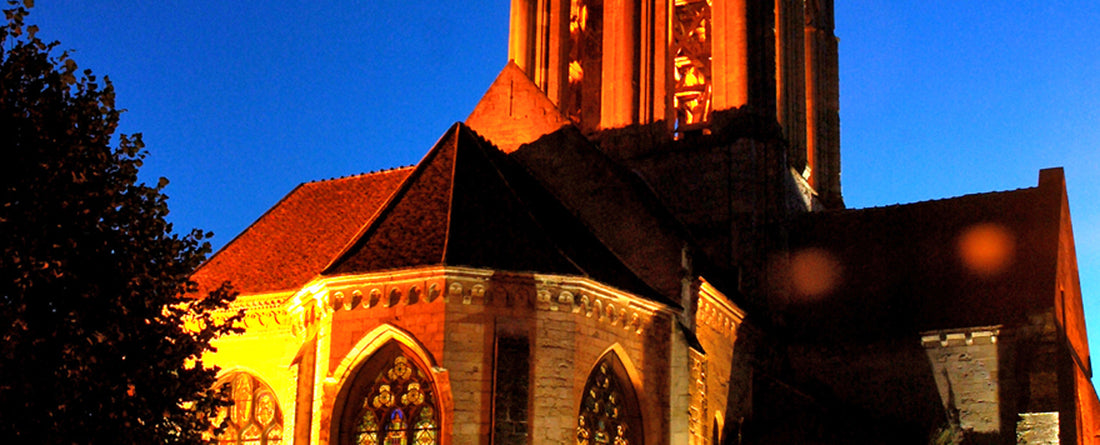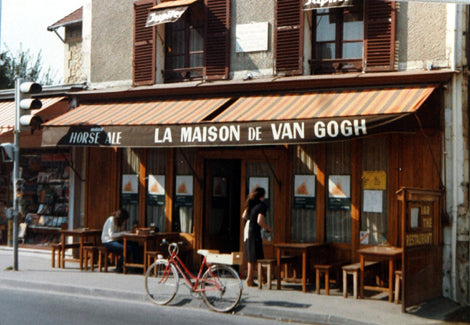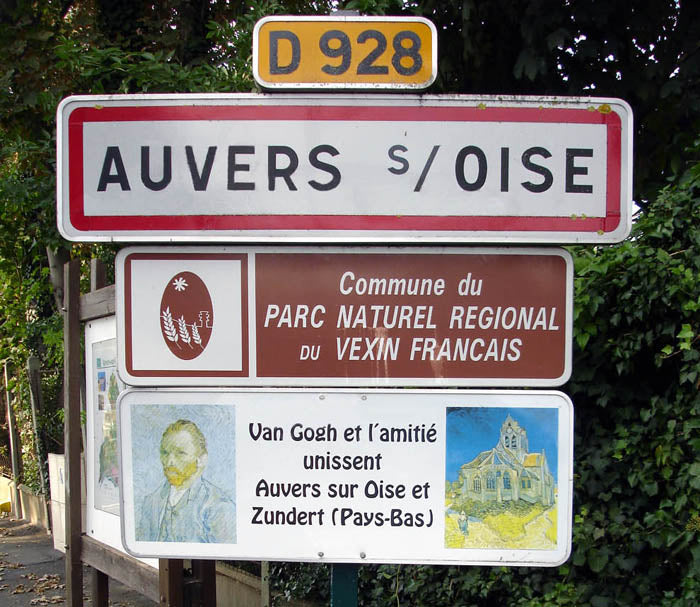
Van Gogh in Auvers-sur-Oise
Van Gogh lived and worked in Auvers-sur-Oise for the last 70 days of his life.
I’ve been to Auvers, just north of Paris, a number of times throughout my life – the first time was in 1982. There’s plenty here to interest both casual art-loving tourists and Vincent van Gogh aficionados alike. Many of the places he painted still exist.

In the footsteps of van Gogh in Auvers
Auberge Ravoux in 2007
Even back in 1982, there were helpful, unobtrusive boards displaying reproductions of Vincent’s works dotted around the village near to the sites that they portray. And there are many sites to see!
This blog considers the main sites, the Auberge Ravoux, the church, and the cemetery. Other sites are mentioned. Dr Gachet’s house is also in Auvers-sur-Oise.

Auberge Ravoux
Vincent lodged here for 70 days in summer 1890. He died in the pokey attic room on 29 July.
When I visited in 1982 (pictured) it was called the “Cafe La Maison van Gogh”, a relaxed and simple cafe/bar. I sat outside and when I had drunk enough beer to summon the courage, I asked the barman if he would let me see “la chambre de van Gogh, s’il vous plait”, which he did. No entrance fee, no fancy audiovisual presentations, no gift shop.

The attic room in which van Gogh died
By 1997, the place had changed. It had been restored to how it was in 1890 and become a visitor centre, with a ticket office, gift shop and multi-media display in various languages. And by 2007,the front part of the building had become a hopelessly overpriced restaurant from which we were barred as there was nothing whatever for vegetarians.
Vincent’s tiny room upstairs is unchanged, however, and remains as oppressive and dismal as ever, poorly lit by a single skylight. A guide showed me the holes in the plaster on the walls, reputed to be where Vincent drove in nails to hang his pictures. The printed literature you get when you buy your ticket says about the room: “There is nothing to see, but everything to feel.”

The church at Auvers
Notre-Dame de l’Assomption church remains virtually unchanged from when Vincent was here.
Its belfry slats, like sad eyelids, so clearly seen on Vincent’s painting are now gone. Now you can see the massive internal timber structure from which the bells are hung. It’s easy to find the exact point from where Vincent must have sat to paint the church. It’s at the rear, on the lane that leads up the hill towards the cemetery.
Interesting to note that he chose this view, and not the other side featuring dramatic flying buttresses and beautiful rose window. Or the old, uneven steps leading up from the Rue Daubigny, which Kirk Douglas ran down in “Lust for Life” a Hollywood biopic of Vincent’s life. The rear view must have reminded him of the chapel at Nuenen in Brabant where he and his parents once lived.
Sketching the church

Me outside the church in 1997, and my watercolour sketch
As I began my own watercolour sketch, the accuracy of Vincent’s drawing quickly became clear to me, in correct proportion in all respects with the exception of the tower, which he shortened to fit in his canvas. The genius of his composition is in the expression of course, and those colours! Sketching it was a fascinating exercise in which I fleetingly glimpsed some of the ways of seeing that Vincent used.
Whilst I was sitting sketching, I was frequently disturbed by visitors, Japanese, German, French, American, most people paused just long enough to take a photo. No one seemed to take the time to really look.
See the real thing
I took the short train ride from Auvers to Paris to see the Vincent’s painting of the Church at Auvers at the Musee d’Orsay. Having already seen so many of his paintings for real over the course of my life, I wasn’t surprised to find that the real thing is more sumptuous, and more radiant than you can possibly imagine.

The church at Auvers photo by my husband Moth Clark
Much has been written about the symbolism in Vincent’s painting. The fact that it’s the back of the church, a church (in the wider sense) which he felt alienated from, as he increasingly put his ‘faith’ in the natural world. I don’t know how much of that is true. But what I do know is that this the priest of this church, which Vincent immortalisd on canvas one sunny spring day in 1890, would later that summer refuse to host his funeral because he committed suicide. So much for christian charity and compassion.
On my last evening in Auvers, my husb and I sat at the roadside, at the exact spot where Vincent set up his easel, and set up our camera on the tripod to take this shot. We were aiming to get the blue of the sky as deep as Vincent’s.

The cemetery
Take the sunken lane north from the church as the land rises out of the Oise Valley. The cemetery was practically new when Vincent was lowered into the ground here. His and his brother Theo’s graves, up against the back wall, are now some of the simplest memorials in a busy cemetery.
On my first trip here 40 years ago, we had the place to ourselves. It’s not like that now. But take your time and you might just get a few minutes peace with the painter and his brother.
Other sites
As you stroll around Auvers, and especially if you are familiar with Vincent’s work, you’ll find yourself looking at more less the same things as he did. For example:
The site of La Mairie, the Town Hall, is obvious and unchanged. Plus, it’s directly opposite the Auberge.

The fields painted by Vincent in “Wheatfield with crows”
A short walk north up the sunken lane behind the church takes you into the great rolling fields above the Oise valley. This is where Vincent painted Wheatfield with crows, supposedly his last ever painting. And perhaps even the field where Vincent shot himself.
Thatched Cottages at Cordeville is more problematic to locate precisely. The junction at Cordeville is so changed that I wasn’t able to identify exact buildings. But the spirit of the old village is still present. It’s easy to imagine what it must have been like. What Vincent saw as allotments between the road and the river is now smart middle class homes with tubs of geraniums.

Changes
Since I first visited, the biggest change is of course more tourists and the infrastructure to cope with them. Back in 1982, apart from locals, my friend and I were the only visitors at the Auberge. In 1997, when I was sketching in the fields behind the cemetery, I was disturbed only by the occasional “bonjour” from dog walkers. Ten years later groups of tourists stroll by.
Finally, here’s a lovely touch. Auvers, the place where Vincent ended his life, is twinned with Zundert in the Netherlands where Vincent was born.

Are you an admirer of Vincent van Gogh?
Check out my hand painted map “The life and works of Vincent van Gogh”
This blog was first published in 2007. Reworked and republished in 2023.



